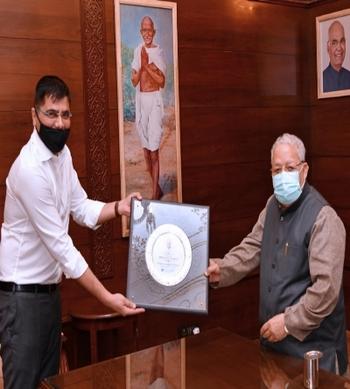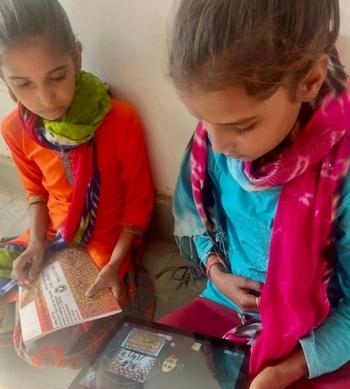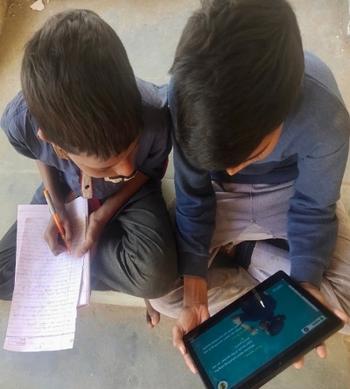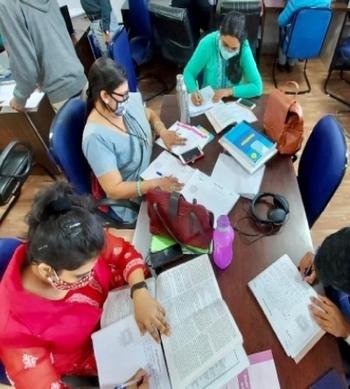CBSE Class 11 Geography Syllabus 2022-2023
The CBSE Class 11 Geography Syllabus 2022-2023 is available in PDF format in this page. This syllabus is in accordance with the yearly assessment scheme, which calls for one annual examination based on the entire curriculum at the end of the academic year. The CBSE Class 11 Geography Syllabus 2022-23 is useful for understanding the course structure and material recommended by the board for the current academic session.
There are total 10 units prescribed for the theory paper. These units are clubbed into two parts :
- Part A: Fundamentals of Physical Geography(35 marks)
- Part B: India-Physical Environment(35 marks)
Skip to
Check CBSE Class 11 Geography (Code No.029) Course Structure 2022-23 below
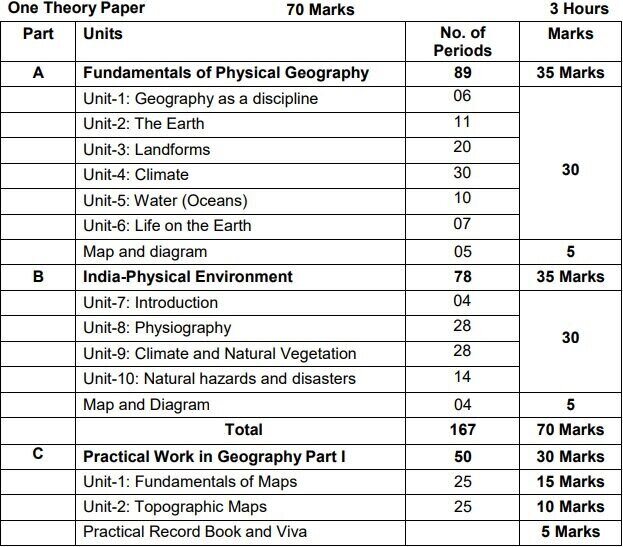
Download CBSE Class 11th Geography Syllabus
COURSE CONTENT
Part A: | Fundamentals of Physical Geography | 89 Periods |
Unit 1: | Geography as a Discipline l Geography as an integrating discipline, as a science of spatial attributes l Branches of Geography: Physical Geography and Human Geography | 06 Periods |
Unit 2: | The Earth l Origin and evolution of the earth l Interior of the earth Earthquakes and volcanoes: causes, types and effects l Distribution of oceans and continents : Wegener's continental drift theory and plate tectonics | 11 Periods |
Unit 3: | Landforms l Geomorphic processes: weathering; mass wasting; erosion and deposition; soil-formation l Landforms and their evolution- Brief erosional and depositional features | 20 Periods |
Unit 4: | Climate l Atmosphere- composition and structure; elements of weather and climate l Solar Radiation-Insolation-angle of incidence and distribution; heat budget of the earthheating and cooling of atmosphere (conduction, convection, terrestrial radiation and advection); temperature- factors controlling temperature; distribution of temperature-horizontal and vertical; inversion of temperature l Atmospheric circulation and weather systems - Pressure-pressure belts; winds-planetary, seasonal and local; air masses and fronts; tropical and extra tropical cyclones l Water in the atmosphere-Precipitation evaporation; condensation-dew, frost, fog, mist and cloud; rainfall-types and world distribution l World Climate and Global Concerns | 30 Periods |
Unit 5: | Water (Oceans) l Basics of Oceanography l Oceans - distribution of temperature and salinity l Movements of ocean water-waves, tides and currents; submarine reliefs | 10 Periods |
Unit 6: | Life on the Earth l Biosphere - importance of plants and other organisms; biodiversity and conservation | 07 Periods |
Map work on identification of features based on 1 to 6 units on the outline Physical/Political map of the world. | 05 Periods | |
Part B: | India-Physical Environment | 78 Periods |
Unit 7: | Introduction l India : Location, space relations, India's place in the world | 04 Periods |
Unit 8: | Physiography l Structure and Relief; Physiographic Divisions l Drainage systems: Concept of river basins, watershed; the Himalayan and the Peninsular rivers | 28 Periods |
Unit 9: | Climate, Vegetation and Soil l Weather and climate - spatial and temporal distribution of temperature, Indian monsoon: mechanism, onset and withdrawal l Natural vegetation-forest types and distribution; wild life; conservation; biosphere reserves | 28 Periods |
Unit 10: | Hazards and Disasters: Causes, Consequences and Management l Floods, Cloudbursts l Droughts: types and impact l Earthquakes and Tsunami Cyclones: features and impact l Landslides | 14 Periods |
Map Work of features based on above units for locating and labeling on the outline Political/Physical map of India | 04 Periods | |
Part C: | Practical Work in Geography Part I | 50 Periods |
Unit 1: | Fundamentals of Maps l Geo spatial data, Concept of Geographical data matrix; Point, line, area data l Maps - types; scales-types; construction of simple linear scale, measuring distance; finding direction and use of symbols l Map projection- Latitude, longitude and time, typology, construction and properties of projection: Conical with one standard parallel and Mercator's projection. (only two projections) | 25 Periods |
Unit 2: | Topographic and Weather Maps l Study of topographic maps (1 : 50,000 or 1 : 25,000 Survey of India maps); contour cross section and identification of landforms-slopes, hills, valleys, waterfall, cliffs; distribution of settlements l Satellite imageries, stages in remote sensing data- acquisition, platform and sensors and data products, (photographic and digital) | 25 Periods |
| Practical Record Book and Viva Voce Viva to be based on Practical Unit I and II only |
|
Conclusion
In conclusion, the CBSE Class 11th Geography syllabus covers a wide range of topics related to the study of the Earth's physical and human features. It aims to develop students' understanding of various geographical concepts, processes, and their interrelationships. The syllabus provides a holistic view of the world and enables students to analyze and interpret geographical phenomena.
FAQs
Q1: What is the importance of studying Geography in Class 11?
A1: Studying Geography in Class 11 helps students develop a deeper understanding of the Earth's physical and human features. It enables them to analyze the relationships between different geographical phenomena and their impacts on the environment and human societies.
Q2: What are the main topics covered in the CBSE Class 11th Geography syllabus?
A2: The main topics covered in the CBSE Class 11th Geography syllabus include Physical Geography, Human Geography, Practical Work, and Map Work. Physical Geography covers topics such as Earth's origin, interior, landforms, climate, and water resources. Human Geography focuses on topics like population, migration, settlements, economic activities, and regional development.
Q3: How is the CBSE Class 11th Geography syllabus structured?
A3: The CBSE Class 11th Geography syllabus is divided into two parts: Part A and Part B. Part A covers the Fundamentals of Physical Geography, while Part B focuses on India: Physical Environment. Each part consists of multiple chapters that delve into specific topics in detail
Q4: Are there any practical components in the CBSE Class 11th Geography syllabus?
A4: Yes, the CBSE Class 11th Geography syllabus includes practical work. It involves activities like map interpretation, map reading, and data analysis. These practical exercises aim to enhance students' skills in understanding and analyzing geographical information.
Download CBSE Class 11th Geography Syllabus PDF

MissionGyan Team
We aim to eradicate the education gap and serve equal and free education to all with the help of skilled and expert volunteers and teachers.

